Feb-09-19
 | | KEG: After two lethargic draws in the first two rounds at Munich 1900 (in which he failed to make a serious effort to exploit his winning chances), Schlechter--going into this game--had won seven of his last eight games and drawn the other (with Pillsbury). He was tied for first with Pillsbury going into this 11th round game, and be defeating Halprin moved--thanks to Pillsbury's draw with Burn--into sole possession of first place a half-point ahead of Pillsbury and Maroczy. This was, I believe, the first time in his career in which Schlechter had held sole possession of first place in a major international tournament. (Pillbury caught up in next round). The game itself is something of a mystery. Schlechter managed to reduce to a double Rook ending in which he was a pawn ahead, but seemed unable to find a winning plan. The score ends on move 63 at which point Schlechter had still made no progress. Somehow or another, he finally won the game, but the "how?" question is apparently lost to history: 1. d4 d5
2. Nf3 Nf6
3. c4 c6
A form of Slav defense to the Queen's Gambit Declined. Neither player seems to have been attuned to the theory of the Slav--perhaps because the theory had not yet been developed. 4. Nc3 Bf5
4...e6 or 4...dxc4 seem theoretically better, but the text has been played--for example by Capablanca in a game he won against Janowski--and is certainly playable. It is always tempting in the Queen's Gambit to find a way to develop the c8 Bishop. The problem, of course, is the potentially weakened Queen-side. 5. Qb3
The text, though once played by Rubinstein, can't be best. 5. cxd5 or 5. e3 give White the better game here. 5... Qb6!
The only move to hold the balance. Black is now fine. 6. c5
Schlechter might as well just have traded Queens here, and after 6. QxQ axQ 7. cxd5 Nxd5 8. e4 NxN 9. fxB Ne4 had somewhat the better chances (his two Bishops compensating for his isolated d-pawn and doubled f-pawns. After the text, Halprin was able to get a nearly even game with ease: 6... QxQ
7. axQ
This left:

click for larger view7... Na6
Preventing b4, but the cure was perhaps worse than the disease. 7...Ne4 was best. Alternatively, if he was worried about a White advance on the Queen-side, Halprin could just have played 7...a6 8. e3
"8. e4!"--Tournament Book.
The Tournament Book certainly looks right. Schlechter should have played 8. e4. With the text, any edge Schlechter had enjoyed was gone. 8... Nb4!
The threatened Knight fork on c2 forces Schlechter to scramble. 9. Ra4
An ugly move, but nothing else looks any better. 9... Nd3+
10. BxN BxB
The position was now:

click for larger viewHalprin had at least equalized.
11. Ne5
"!"--Tournament Book.
11... Bf5
This Bishop may be needed on c8
12. Rb4 Bc8
13. Bd2 Nd7
14. NxN KxN
15. Ra4 e6
15...e5 looks more dynamic, but the text seems good enough to hold the balance. 16. b4
16. e4 or 16. 0-0 may be best, but Schlechter decided to launch operations on the Queen-side. 16... a6
17. b5 cxb5
18. Nxb5 Kc6
The King is a fighting piece, sometimes even with many pieces on the board. 19. Nc3 b6
"!"--Tournament Book.
20. cxb6
20. b4 would allow him to keep his pawns connected and thus seems better. 20... Kxb6
21. 0-0 Bd7
The position was now:
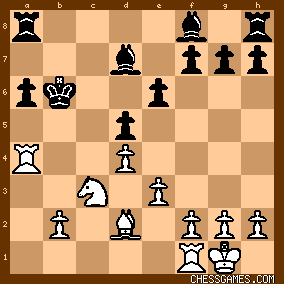
click for larger viewMaterial had been reduced but there was still a lot of play in the position. As I will discuss in my next post on this game, the battel soon heated up. |
|
Feb-09-19
 | | KEG: Post II
22. Ra2 Be7
23. Na4+
23. e4 is more aggressive, but the resulting second isolated pawn seems too serious a consequence and the text thus was probably best. The position after 23...Na4+ was:

click for larger viewSimplest and probably best here was either 23...Kb7 or 23...BxN. But instead, Halprin played: 23... Kb5
The first of what proved to be a series of moves by Halprin in which his King marched into the belly of the beast, and wound up far advanced on the Queens-side where it was out of play and subject to mating threats. This curious strategy may well explain Halprin's loss in this game (to the extent I am able to fathom anything concerning the ending of this game). 24. Ba5
"?"--Tournament Book.
Schlechter here initiated a little combination which, though it did not lose material, gave Black much the better game. Schlechter had many better moves here: 24. Rc1; 24. Nc5; 24. b4; 24. Rfa1. But Schlechter seems to have fallen into the habit from which many of us suffer: preferring to play a nifty little combo that does nothing good for one's game. 24... KxB
25. Nc5+ Kb5
26. NxB
This left:
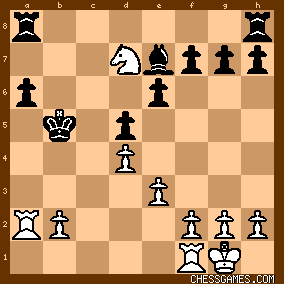
click for larger viewSchlechter now has to take care to avoid losing his wayward Knight (or a pawn in the process). In any case, Halprin's Bishop is better than Schlechter's Knight. Both sides had an isolated weak pawn. On balance, Halprin was better at this point. 26... f6
This should not have caused Schlechter any problems. Better were 26...Rhc8 or 26...a5. The position was now:
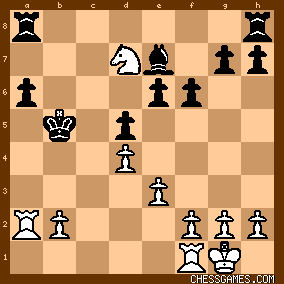
click for larger viewThe Knight needs an escape route, and c5 is all that is left. But Schlechter chose the wrong way to use this exit strategy: 27. Rc1?
Too clumsy. 27. Rfa1 was the best route to salvation. After that, White's double attack on the Black a-pawn compensates for the possible loss of a pawn after an exchange following Nc5. After the text, Halprin should probably have won the game. 27... Rac8
"?"--Tournament Book.
"27...Rhc8"--Tournament Book.
27...Rhc8 does seem to win: e.g., 28. Rca1 a5 and White loses a pawn after his Knight goes to c5, BxN, dxB, Rxc5. 28. Rca1
"!"--Tournament Book.
28... Kc6
Asking for trouble. 28...Ra8 leaves Black with approximately even chances. 29. Nc5 BxN
30. dxB Kxc5
Halprin could equally well play 30...e4 first and then 31...Kxc5. 31. Rxa6 e5
The position was now:
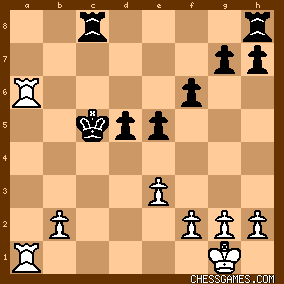
click for larger viewSchlechter has better chances here, but Halprin should almost certainly have been able to hold the game. The passed White b-pawnis almost as much a weakness as a strength. But, as I will discuss in my next post on this game, Halprin from here bungled the ending and wound up in trouble. |
|
Feb-09-19
 | | KEG: Post III
Double Rook endings are terribly difficult, and the players at this stage did not always choose the best lines: 32. R6a5+
This should only have driven Halprin's King to a safer location. Schlechter should either have begun to bring his King into play with 32. Kf1 or have attacked the King-side with 32. Ra7. 32... Kc4
"32...Kc6"--Tournament Book.
The Tournament Book was surely correct that Halprin should have brought his King back to his terrain, as Schlechter's poor 32nd move allowed him to do. 32...Kd6 was even better than the Tournament Book's suggested move. But Halprin, consistent with his tactics throughout this game, marched his King into enemy territory, almost asking for trouble: 32... Kc4?
33. b3+
33. Kf1 was probably better. But Schlechter had decided to rid himself of his isolated pawn and try to win based on the vulnerable position of the Black King: 33... Kxb3
There was no rush to snatch this pawn. With 33...Kb4 34. Rxd5 Rhd8 35. RxR RxR Black ultimately takes the White b-pawn with a better position than he obtained after the text. 34. Rxd5
The position was now:

click for larger viewWhite's advantage lies in the respective positions of the two Kings. Black has various ways to try to handle his problems. The easiest seems to be 34...Ra8 (seeking to trade Rooks). Alternatively, he could have played 34...Rcd8 or 34...h5. 34... Rc7
Not a losing move, but allowing Schlechter to continue to control the d-file and to keep the Black King in a precarious site where mating threats can easily develop. 35. g4
While Schlechter's King-side plan ultimately yielded him a pawn, this was the result of questionable play by Halprin. 35. Kf1 or 35...Rdd1 were better. 35. Rd3+ was another option to be considered. 35... h5
35...Kb2 would force White's play. 35...Rf8 was another possibility. The text allowed Schlechter to move forward with his King-side plan. 36. g5!
Suddenly, Black's King-side was in jeopardy:

click for larger view36... h4
Playing into Schlechter's hands. 36...Kb2 or perhaps 36...Rhc8 were better. 37. h3
37. gxf6 and 37. Rb1+ were also good.
37... Rh5?
He should have played 37...Rf8 or 37...Kb2.
The position after 37...Rh5 was:
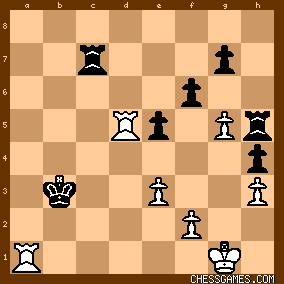
click for larger viewHalprin's position was now hanging on a thread, and--as I will discuss in my next post on this game--matters from here went downhill for Halprin until he lost a pawn. |
|
Feb-10-19
 | | KEG: Post IV
38. gxf6 Rg5+
The simple 38...gxf6 would have been better. But best was probably 38...Rf5 since if then 39. fxg7 (39. Rb5+ is better here) Rxg7+ 40. Kf1 (40. Kh1 would actually lose to 40...Rf3! 41. Kh2 Rxf2+ 42. Kh1 Rf3 43. Kh2 Rgg3) Rgf7 and Black is very much back in the game (e.g., 41. Rd2 [41. Rb5+ is best] Rf3 42. Kg2 e4). 39. Kf1 gxf6
This left:

click for larger viewIs this position a theoretical win for White? I am not sure. The game itself does not answer the question. 40. Rb1+ Kc2
Continuing what could and probably should have been a death march for his King. 40...Kc4 was best. 41. Rb4
Choosing the wrong target. 41. Rb6 was much stronger. 41... Rh5?
Very weak. He should have played 41...Rc6 or perhaps 41...Kc3 (42. Rxh4 Ra7). 42. Rd6
42. Rb6 was more accurate.
42... Kc3
43. Rbb6
43. Rb1 (43...Kc2 44. Rb5) was better.
The position was now:

click for larger view43... f5!
This dynamic move may or may not be the best theoretical chance to save the game, but it sets problems for White that Schlechter proved unable to solve. Thus, since this was an over-the-board contest, I give the move a "!" 44. Rb5
Or 44. Rd5.
44... f4!
Better than 44...e4 45. Rf6 (or 45. Rdd5).
45. exf4
This left:

click for larger view45... Rf5!
46. fxe5 Rcf7
47. Rc5+ Kb4
48. Rc2 Rxe5
This left:
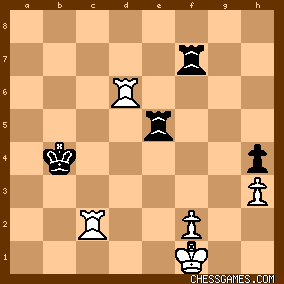
click for larger viewIs this position a win for White? I will discuss Schlechter's efforts to win from here in my next post on this game. |
|
Feb-10-19
 | | KEG: Post V
49. Rb2+
If there is a win here for White it likely begins with either 49. Rb6+ (trying to exploit the mating threats in order to win the Black h4 pawn) (e.g., 49. Rb6+ Ka3 50. Rc8 (threatening mate) Ra5 51. Rc3+ Ka2 52. Rb4 Raf5 (52...Rh5 53. Rcc4 Rfh7 54. Ke1 Rf5 55. Rxh4) 53. Rc2+ Ka3 54. Rxh4 Alternatively, 49. Rd4+ may be a simpler way to the same end. I do not suggest that the above is anything close to a thorough analysis of the possibilities in this endgame. One thing seems sure: Schlechter's move was not best. 49... Kc5
Continuing to follow his potentially disastrous idea of marching his King into Schlechter's territory. 49...Kc3 was a much better try. 50. Rd8 Ref5
Another ill-judged move. 50. Re4 or 50...Rf4 or even 50...Rh7 were better. 51. Rc2+ Kb4
52. Rb8+
Hard to understand why Schlechter didn't play the seemingly obvious 52. Rd4+. I'm not sure this wins, but why not give it a try? 52... Ka3
53. Ke1
"?"--Tournament Book.
53. Re2 or 53. Rd2 were certainly better.
After 53. Ke1?, the position was:
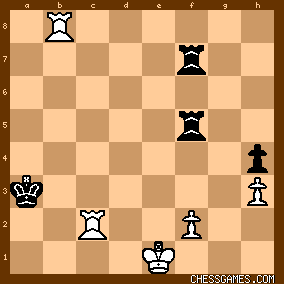
click for larger view53... Rf4
As pointed out in the Tournament Book, Halprin should have played 53...Rf3! 54. Rc6
54. Rc3+ or 54. Rc1 were better tries.
54... Ra4?
Still tempting fate. 54...Rb4 or 54...Ra7 offered better chances. 55. Kf1 Rf5
He should have played 55...Rf3 or 55...Ra5 here. 56. Rg6
Schlechter could have taken advantage of Halprin's weak play with 56. Rcb6. 56... Rff4
Perhaps 56...Rf3.
57. Kg2 Ka2
This left:
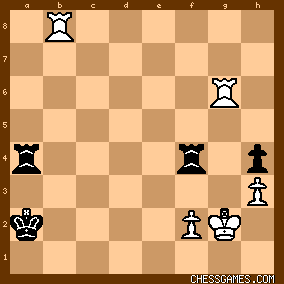
click for larger viewThe following jockeying for position did not materially change either side's prospects: 58. Rbg8 Ra3
58...Ra7 or 58...Rf5...or perhaps 58...Ra5 were arguably better chances. 59. Rg4 Rf7
60. Rb8
If 60. Rxh4 Raf3.
60... Ka1!
61. Kg1
If 61. Rxh4 Ra2
61... Rh7
61...Ra2 looks better.
62. Rgb4 Ra6
63. Rg8
The position now was:
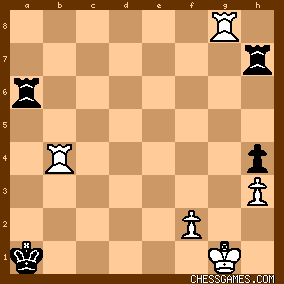
click for larger viewThe score ends either here or (in some accounts) after Black played 63...Ra5. It is unclear what happened after this. Schlechter was credited with a win, but I see nothing to indicate that Halprin resigned or that the game continued. Anyone have any information on this?
Given Schlechter's inability to wrap up the game to this point, and given the difficulty of double Rook endgames, it is hard to know what to make of the finish. Even with the help of two computer engines, I am not sure whether the final position (with or without 63...Ra5 if that was indeed played) is a theoretical win. One thing is for sure, winning this over board against persistent and competent opposition would be no easy task. |
|
Feb-10-19
 | | beatgiant: <KEG>
The final position seems like it should be won for White. Black's king is cut off in the corner on the opposite side from the pawns, Black's h-pawn is exposed, and if White manages to exchange one pair of rooks, it usually becomes a book win.But, I agree it's very hard to prove anything definitely. I tried playing out a few lines and found it's hard for Black to avoid a rook trade, which I think doesn't bode well for Black's chances of holding it over the board. |
|
Feb-11-19
 | | KEG: <beatgiant>
Thank you for your comment.
Everything I know about endings suggests that there must be a way for White to win in the final position, but--even with computer assistance--I have not been able to satisfy myself that this is definitively the case. Both Fritz and Stockfish give White a big plus, but neither seems to have any great ideas on how to go about winning. After struggling with the ending for a day or so, I decided just to put up my posts and either come back to it later or hope that one of the fine analysts on this site such as you would arrive at a definitive solution. With the Black King out of play on a1, my gut tells me this must be a win for White. |
|
Feb-11-19
 | | offramp: Here is what I think happened: at some point Halprin forgot about the mate threat to his king and he made a blunder. For example, 63... Ra5 64. Kg2 Ra6 65. Kf3 Rf7+ 66. Ke2 Raf6 67.Ra8+ and a mate in three. I reckon both players were embarrassed at such an outcome, Halprin for the blunder and Schlechter for winning in such a crass way, and they changed the score to the simple "63...Ra5 and White won". |
|
Feb-11-19
 | | KEG: <offramp>Your conjecture is interesting, but given the many games won as a result of blunders at Munich 1900 in which the losing blunders WERE reported in the Tournament Book, I am loathe to assume that an exception was made to spare Halprin embarrassment. I agree with beatgiant that, in practice even if not in theory, White has excellent winning chances, in part because of the mating threat you mention. Given the joint effort of Schlechter and Maroczy to coach Halprin in his 14th round game against Pillsbury, and given that Schlechter wound up in a three-way tie for first with Pillsbury and Maroczy in part because of the draw Halprin achieved through the coaching of Maroczy and Schlechter and in part because of Schlechter's "victory" in this game, I wonder if some deal was struck. Whatever the theoretically correct outcome in the ending, it seems clear that Schlechter had not figured out a winning plan. |
|
Feb-11-19
 | | beatgiant: If I were White here, I would start with 64. Rg8-g4 (threatening a rook trade on a4 and also hitting the h-pawn), maneuver the rook to e4, and start pushing the f-pawn. Here's an example of passive Black defense.
61. Rgg4 Rah5 62. Rge4 Rh8 63. f4 (now White threatens Re5, forcing a rook trade) R5h7 64. f5. White is making visible progress. If Black tries to play more actively, White is also usually able to force a rook trade. |
|
Feb-12-19
 | | KEG: <beatgiant>Thank you for this excellent analysis. If White has a win, your method is likely the way to victory. Your 64. Rgg4 is probably the best try, and does seem to be sufficient to win. (I had been looking primarily at 64. f4). In your line, after 64...Rah5 (seemingly forced) 65. f4 looks even stronger than your 65. Rge4 (which may also win, though 64...Ka2 or 64...Rg5+ or 64...Rg7+ may create problems). After 64. Rgg4 Rah5 65. f4 I see no saving line for Black. In sum, your 64. Rgg4 appears to solve the riddle. Unless I am missing something (and I did miss the power of 64. Rgg4 before playing f4), Schlechter did indeed have a win at the point the record breaks off. I looked at 64...Rf5 65. Rxh4 Rhf7 66. f4, but then White is up two pawns with a win in sight, so your 64. Rgg4 seems to win in this variation as well. Great work! Thank you. |
|
Feb-12-19
 | | beatgiant: <KEG>
You're right, 64. Rgg4 Rah5 and now the immediate <65. f4>, and White continues simply offering rook trades and advancing the f-pawn, and I see no defense to that plan. Dropping a second pawn doesn't help Black. |
|
|
|
|





































